 Multiple Choice Questions
Multiple Choice QuestionsFollowing statements were made regarding vulval development in Caenorhabditis elegans:
(a) The six vulval precursor cells (VPCs) are influenced by the anchor cell to form an equivalence group.
(b) In the loss of function lin-12 mutants, both cells become uterine whereas in gain of function mutants, both become anchor cell.
(c) If the anchor cell is destroyed early in development, all the six VPCs divide once and contribute towards the formation of hypodermal cells.
(d) The anchor cell/ventral uterine precursor decision is due to Notch-Delta mediated mechanism of restricting adjacent cell fates.
(e) The paracrine factor secreted by the anchor cell directly activates the Notch-delta pathway. Which one of the following options represents a combination of correct statements?
(a), (c) and (d)
(a), (b) and (d)
(c), (d) and (e)
(b), (d) and (e)
Given below are few statements regarding the role of Disheveled (Dsh) and β-catenin (β-cat) in the development of sea urchin.
(a) Dsh is localized in the vegetal cortex of the oocyte before fertilization and in the region of the 16-cell embryo about to become the micromeres.
(b) Dsh is localized in the cytosol of the oocyte during oogenesis and in the micromere forming blastomeres of a 16-cell embryo.
(c) β-cat accumulates predominantly in the micromeres and somewhat in the veg2 tier cells.
(d) Treatment of embryos with lithium chloride does not allow the accumulation of β-cat in the nuclei of all blastula cells, and the animal cells thus become specified as endoderm and mesoderm.
(e) When β-cat is prevented from entering the nucleus, the embryo develops as a ciliated ectodermal ball.
Which one of the following options represents a combination of correct statements?
(b), (c) and (e)
(a), (c) and (d)
(a), (c) and (e)
(b), (d) and (e)
Which one of the following statements regarding limb regeneration in Salamander is correct?
A normal limb is regenerated after amputation, irrespective of whether the cut was made below the elbow or through the humerus.
It occurs by compensatory regeneration and does not include formation of an apical ectodermal cap.
Regeneration occurs through formation of a blastema, which essentially consists of unspecified multipotential progenitor cells.
Proliferation of the blastema cells does not require nerves or factors secreted by the nerves.
Change in leaf morphology is observed during transition from vegetative to reproductive phase in several plants. The following statements are proposed to explain the above observation:
(a) Alteration in the gene content of leaves of reproductive phase from those of vegetative phase.
(b) Differential methylation pattern of genes influencing leaf development and morphology.
(c) Mutation in transcription factor that prevents its association with promoter elements of genes regulating leaf development.
(d) Small RNA mediated inhibition of gene expression of a homeotic gene.
Which one of the following options represents a correct combination of statements that could explain the observed changes?
(b) and (c)
(a) and (d)
(b) and (d)
(a) and (c)
Torpedo, is known to serve as a receptor for Gurken. Deficiencies of the torpedo gene in Drosophila cause ventralization of the embryo. In an experiment, the germ cell precursors from a wild type embryo were transplanted into embryos whose mother carried the torpedo mutation. Also, the reverse experiment, i.e., transplantation of germ cell precursors from torpedo mutants into wild type embryos was done. The torpedo deficient germ cells developed in a wild type female showed normal dorso-ventral axis, while the wild type germ cells developed in a torpedo deficient female showed ventralized egg. Some of the following statements are drawn from the above experiments and some from known facts to understand the functioning of Torpedo.
(a) Zygotic contribution of Torpedo is essential for the development of dorso-ventral axis.
(b) Maternal contribution of Torpedo is essential for the development of dorsoventral axis.
(c) Since Torpedo is a receptor for Gurken and follicle cells surround the part of the oocyte where Gurken is expressed, it is likely that Torpedo is expressed in follicle cells.
(d) Gurken signalling initially dorsalizes the follicle cells, which in turn send signal to organize the dorso-ventral polarity in oocyte.
(e) Gurken signalling initially dorsalizes the nurse cells which help in generation of dorso-ventral polarity in oocyte.
Which one of the following combination of statements is most appropriate?
(b), (c) and (d)
(a), (c) and (d)
(b), (c) and (e)
(a), (d) and (e)
Eg5 is a well-studied protein in Xenopus. To understand the function of Eg5 in mammalian cells, a team of researchers treated mammalian cells during late G2 phase with Eg5-inhibitor. The following diagrams represent images of mitotic cells. Based on the above information, what function might be attributed to Eg5 during mitosis?
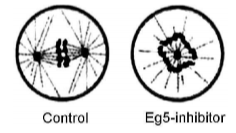
Eg5 inhibits actin dynamics.
Eg5 can activate GPCR signalling.
Eg5 has motor activity
Eg5 can impact mitochondrial dynamics.
Activation-induced cytidine deaminase (AID) is the key mediator of somatic hypermutation, gene conversion and class-switch recombination. In order to ascertain the role of AID in class-switch recombination, immune response against a target antigen was compared between AID knock-out mice (AID-/-) with that of mice retaining a functional copy of the AID gene (AID+/-). Development of IgM and IgG antibodies against the target antigen was then measured following successive immunization and plotted graphically. Which one of the following is the most appropriate representation of the experiment?
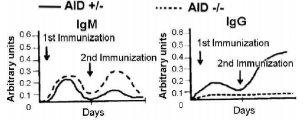
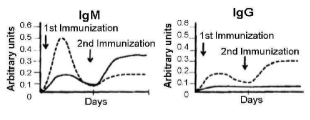
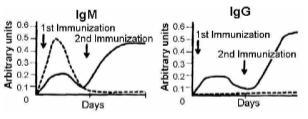
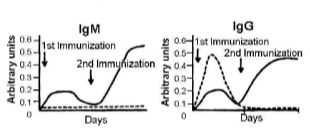
A.

Following are certain statements regarding energy efficiencies of ectotherms and endotherms:
(a) Ectotherms have high assimilation efficiency but low production efficiency.
(b) Ectotherms have low assimilation efficiency but high production efficiency.
(c) Endotherms have high assimilation efficiency but low production efficiency.
(d) Endotherms have low assimilation efficiency but high production efficiency.
Which one of the following represents the combination of correct statements?
(a) and (b)
(b) and (c)
(c) and (d)
(a) and (c)
The following cassette was designed to create estrogen receptors knoc-out mice:

SoH: site of homology; GoI; gene of interest
What would ensure that proper recombination has taken place?
Cells survive when cultured in presence of only G418
Cells survive when cultured in presences of G418 followed by ganciclovir
Cells die when cultured in presences of G418
Cells survive when cultured with G418 and die when cultured with ganciclovir
